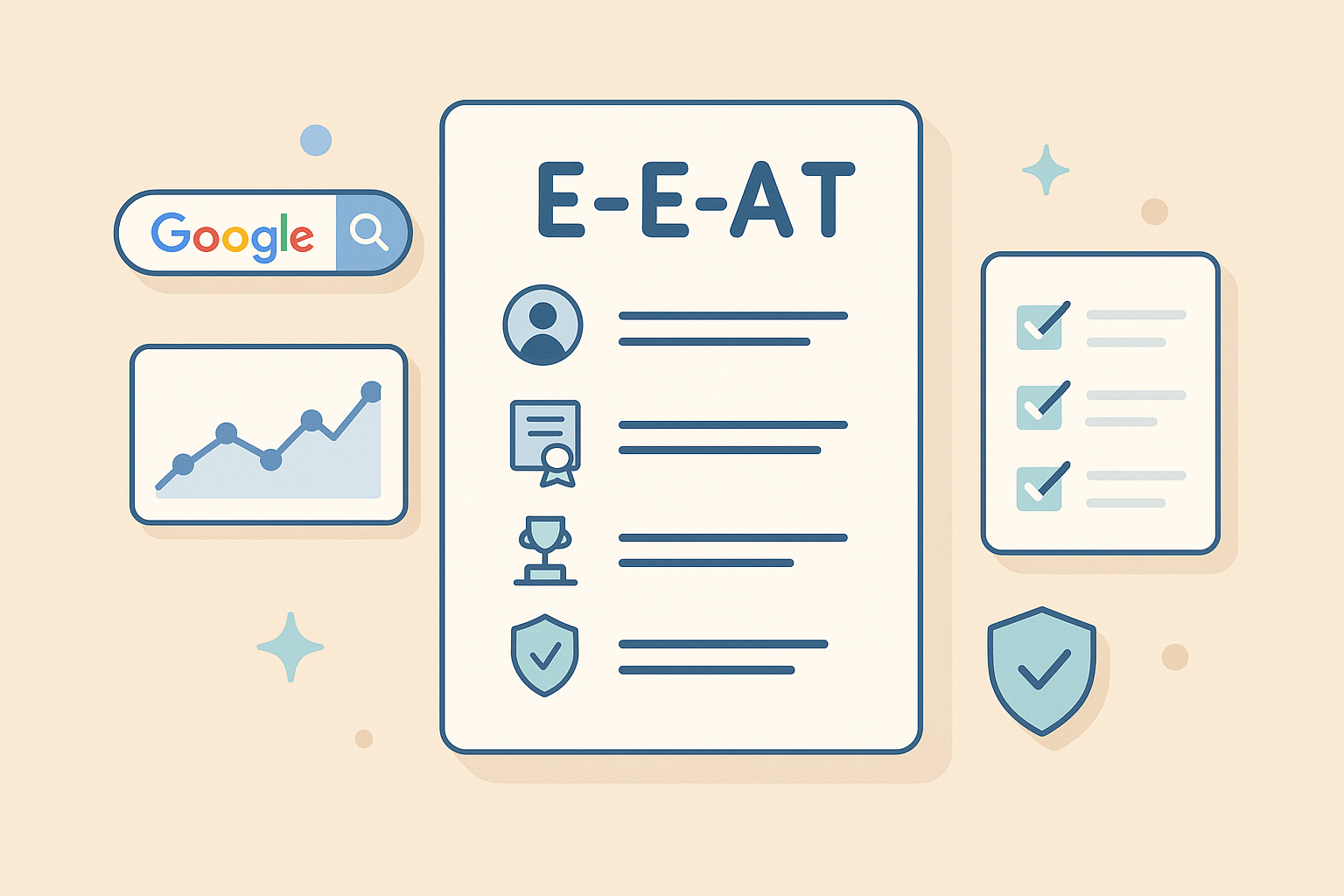Heard the term E-E-A-T thrown around in SEO circles lately? You should—because in 2025, it’s not optional. According to Google’s own Search Central Blog, pages that demonstrate E-E-A-T perform better in search.
So if you’re still publishing fluff or AI-generated content with no human oversight—stop. Let’s talk about what actually works.
What Is Google E-A-T?

If you want your content to show up on Google in 2025, you need to understand E-A-T — short for Expertise, Authoritativeness, and Trustworthiness. Google uses it to decide if your content is helpful or just noise.
What Is E-E-A-T and Why It’s the Real SEO Game-Changer

E-E-A-T stands for Experience, Expertise, Authoritativeness, and Trustworthiness. Google introduced the E-E-A-T framework to help users find trustworthy content faster. Google uses this to check if your content is safe, smart, and written by someone who knows what they’re talking about.
Google now values everyday expertise just as much as formal credentials, especially in topics like parenting or nutrition. It's part of Google’s search quality rater guidelines.
Whether you’re a blog post writer or a site owner, showing real-life experience and quality content helps your search rankings. Want to rank higher? Focus on creating helpful content people actually trust. Google’s search ranking systems prioritize content that meets E-E-A-T standards.
How Google Evaluates Real Experience in E-E-A-T
Not all expertise comes from degrees. Google now recognizes content written by people with real-life experience—called everyday expertise. Whether you're a mom sharing pregnancy tips or a patient explaining a condition, your voice matters.
This shift helps Google connect users with content that feels personal, practical, and trustworthy. The key is to be transparent—share what you’ve lived, cite facts, and show your reason to be trusted in that space.
“Curious how AI + human synergy boosts your ranking factors? Download J6’s whitepaper for data-driven insights.”
Why the Content Created Matters More Than Ever
Google isn’t just looking at what your page says—it’s asking, who wrote it, and why should we trust them? In 2025, the content created must reflect real expertise, honesty, and purpose.
Let’s make this simple:
- Google values content from content creators with real subject matter expertise.
- Pages with clear authorship and factually accurate content rank better.
- Content must be helpful, not fluffy. That means it should solve real problems or answer real questions.
- It should reflect your brand authority — backed by sources, trust signals, and a strong online footprint.
Whether you're a business, blogger, or healthcare site, publishing quality content that follows E-A-T is not optional anymore. It's the difference between a successful seo strategy showing up in search results or being buried on page 10.
Example: A cooking website that shares personal recipes and real tips from home chefs can still meet E-E-A-T standards.
Sites that focus on building trust and credibility are more likely to achieve long-term SEO success. E-E-A-T should guide every step of your content creation process—from topic research to publishing.
How Search Quality Rater Guidelines Define High-Quality Content

1. Real People Judge Content — Not Algorithms Alone
Google doesn’t rely only on machines. It also uses quality raters — real people who follow search quality rater guidelines to judge if your content is useful and trustworthy.
If your article covers sensitive topics like being pregnant with ovarian cyst, Google wants to show high quality content that helps users, not just pages stuffed with keywords. These raters check whether your content matches the search queries, the searcher's intent, and if it offers value.
How to Implement:
- Write clear, helpful answers to common questions.
- Focus on real problems your audience has.
- Don’t try to trick search engines — write for humans.
2. Clear Purpose Is a Must
Every page must have a clear purpose. Are you informing? Reassuring? Explaining? Especially on medical topics, clarity helps both Google and readers.
Pages without a clear goal can be flagged as low quality. Readers might bounce quickly, which lowers your search rankings and search performance.
How to Implement:
- Use clear titles and headings.
- Write in short, simple sentences.
- Say upfront who the article is for (e.g., women dealing with ovarian cysts during pregnancy).
3. Write on Helpful Content

Helpful content gives readers exactly what they need.
For example, if someone is pregnant with ovarian cyst, they want clear answers that come from adequate expertise —not fluff or clickbait. You should be committed to creating quality content that truly helps you understand managing pregnancy with ovarian cysts.
Google aims to prioritize content that offers real support for those pregnant with ovarian cyst concerns.
Google's search quality rater guidelines reward content that is useful, original, and easy to understand. The content must serve the person—not the algorithm.
How to Implement:
- Answer common questions directly. Pages that include detailed information with proper sourcing are rewarded in search rankings.
- Use bullet points and short paragraphs for easy reading.
- Focus on the reader’s intent. Start with smart keyword research, but focus on content that solves real problems for real people. If someone asks, “Is it safe to be pregnant with ovarian cyst?”, give data, facts, and simple advice.
- Avoid keyword stuffing. Instead, weave in terms like helpful content, quality content, and content marketing where they naturally fit.
“Need help creating high quality content that ranks? Book a free SEO audit with J6 Venture and get expert guidance.”
4. Author Info and Sources Matter
Readers (and Google) want to know who wrote the content and why they should trust them. The e a t guidelines stress the need for expertise authoritativeness and trustworthiness (E-E-A-T), just like effective customer service information.
Articles without named authors, credentials, or reliable links may be flagged as low quality.
How to Implement:
- Add an author bio with qualifications.
- Link to sources like medical journals or trusted health sites.
- Include quotes from real doctors, especially when writing about sensitive topics like “pregnant with ovarian cyst.”
- Use tags like google’s e, content creators, and reputable websites to support trust.
5. User Experience Plays a Role
User experience means how easy and enjoyable your page is to read and use. Google’s algorithm doesn’t just look at words—it also looks at layout. Bad design, slow speed, or confusing headings can harm your search rankings.
How to Implement:
- Use clear headings like this one.
- Add helpful visuals or infographics where needed.
- Make your site mobile-friendly.
- Avoid low quality pages—don’t just create content; aim to create valuable content backed by facts.
6. Original, Fact-Based, and Updated Content Wins

This means your content must be true, based on facts, and updated when things change. If someone searches “pregnant with ovarian cyst,” they want accurate, caring answers. Google’s search quality rater guidelines reward such high quality content.
Fact-based info builds trustworthy source status and improves search rankings, which can also contribute to financial stability. Fresh content helps in search engines like Google.
How to implement:
- Use up-to-date medical sources or studies.
- Share real patient stories (e.g., “I was pregnant with ovarian cyst …”) to show experience.
- Review and refresh your content at least every six months.
- Cite reputable websites and show the date you updated it.
7. Positive Brand Reputation Helps
This means your brand is known and trusted. People and other sites link to or mention you.
When your own content—like about being pregnant with ovarian cyst—comes from a trusted site, Google sees your brand as strong. This lifts your search results placement and shows good brand reputation. Your brand authority grows.
How to implement:
- Include clear author bios and credentials.
- Encourage real patient feedback and online reviews.
- Mention any recognition or partnerships with trusted medical sites.
- Promote helpful content on your social media channels to earn mentions and links.
What Google Considers Low Quality Pages and Content

If you're writing about being pregnant with ovarian cyst, make sure the page is not low quality. Google flags content that’s thin, copied, or lacks factually accurate content. If a blog post is full of fluff, doesn’t cite experts, or skips trusted sources, it’s not helpful.
Low quality pages often miss author info, medical references, or show poor design. They may also push misleading health tips that can hurt people.
To avoid this, create helpful content backed by reputable websites and clear quality guidelines. Use real-life experience, expert input, and simple language that builds trust.
How Google Evaluates Brand Authority and Reputation

- Mentions Across Trusted Sources Matter: Other respected sites (like health journals) mention you. It shows Google your brand reputation is strong. Reach out to medical websites or news outlets to reference your content.
- Positive Online Reviews Help Build Trust: Real people leave good feedback. It boosts credibility in search engines and helps your search rankings. Encourage honest reviews from patients who've read your content.
- Consistency Across Digital Presence: Your info looks the same everywhere—on your website, social profiles, and directories. Consistency builds brand authority and makes you easier to find in search results. Check your name, address, and about pages match across platforms.
- Strong ‘About Us’ and Author Pages Boost Credibility: Pages that clearly say who you are and why you matter. Add staff bios, credentials, and a friendly photo.
- Wikipedia Pages and Knowledge Panels Strengthen Authority: A Wikipedia page or knowledge panel appears beside your site in Google search. They signal high trust and boost google search visibility. Create a well-sourced page or use brand metadata to prompt a knowledge panel.
- Handling Negative Reviews Proactively Matters: You respond politely to criticism. It shows you care about users and build trustworthy source signals. Thank the reviewer and offer help or solutions.
- Featured in High-Authority Media or Lists: You’re interviewed or listed in top health sites. This signals to Google your brand is reputable and boosts search rankings. Pitch expert insights or case studies to journalists and bloggers.
- Backlinks from Trusted Domains Still Count: Links from official organizations or big sites. They are powerful signals in search engines and ranking algorithms. Foster relationships with credible publications and ask for links to your guides.
Can AI-Generated Content Demonstrate E- E-A-T?

AI-generated content is fast and easy. But can it really show experience, expertise, authoritativeness, and trustworthiness (E-E-A-T)? Not always, which is why seo professionals emphasize the need for expert input.
“Want proof that AI-powered SEO can still deliver trust? Try J6 Venture’s AI‑Human SEO Engine to see real results.”
Google looks for content quality, clear author info, and factually accurate content. AI can help write, but it doesn’t have real-life experience or credentials like a doctor or expert. This matters, especially for serious topics—like being pregnant with ovarian cyst.
To meet E-E-A-T standards, content should be checked by humans. Add real expert reviews, clear sources, and solid brand authority. Use AI as a helper, not the final voice.
That’s how you make AI content reliable—and Google-friendly.
How to Align Your SEO Strategy with E- E-A-T Signals

- Showcase Author Expertise: List credentials and experience of the writer. This builds brand authority and helps Google see your expertise authoritativeness and trustworthiness. Add a bio with credentials, especially if the author is a doctor or specialist.
- Build Topical Authority: Cover related topics like pregnancy health, ovarian cyst types, and safe treatments. Google favors sites with deep content quality in a topic. Link between your own guides on high quality content and helpful content.
- Cite Reliable Sources: Cover related topics like pregnancy health, ovarian cyst types, and safe treatments. Google favors sites with deep content quality in a topic. Link between your own guides on high quality content and helpful content.
- Highlight Trust Signals: Show logos, awards, and reviews. They act as trust cues in search results and search rankings. Display certifications, review quotes, and trusted partner logos.
- Ensure Accuracy and Clarity: Write clear, simple sentences with correct info. Accuracy helps your page appear in google search results and avoids being low quality content. Use short sentences, avoid jargon, and verify medical details. To create content Google values, always include clear headings and medical references.
- Improve Site Experience: Make your site fast, clean, and easy to use. A good online content experience boosts search performance. Use readable fonts, mobile-friendly design, and quick loading.
- Earn Quality Backlinks: Get links from trusted domains like health blogs or hospitals. These links tell Google your content is valuable content and reliable. Offer to guest-post or share your research findings.
- Avoid Manipulative SEO Tactics: Do not use hidden keywords or link schemes. Google’s ranking algorithms punish such tricks. Focus on real value, not shortcuts.
- Use Structured Data Where Possible: Add schema markup for medical info or FAQs. This helps Google understand your content and boosts search quality. Use JSON-LD or microdata for key details like author, date, and treatment info.
- Encourage Positive Brand Mentions: Get positive mentions in forums, media, or social media. This builds brand reputation and boosts search rankings. Ask satisfied readers to share or comment, and participate in Q&A forums.
How Content Marketing Supports Long-Term E-E-A-T Growth

1. Showcases Real Expertise at Scale
You can’t fake real knowledge. Google uses signals like author expertise, clear sourcing, and factually accurate content to decide if you’re an expert.
- Create helpful content around real experiences—like managing pregnancy with an ovarian cyst.
- Use expert quotes and medically reviewed facts.
- Add structured data to let Google search recognize the author's background.
2. Builds Trust Brick by Brick
Good content isn’t just smart—it’s consistent. Over time, your positive reputation grows.
- Link to reputable websites and reliable information.
- Update your pages regularly to reflect the latest facts.
- Keep your tone friendly and clear, especially for sensitive topics like high quality content in health.
3. Establishes Topical Authority

Google loves when you go deep—not just wide.
- Write about related subjects like low quality pages, search results, or how Google evaluates content quality.
- Over time, your site becomes a go-to for that topic, signaling e a t and content marketing strength.
4. Earns Natural Mentions and Backlinks
When you write helpful articles—like personal guides for someone pregnant with ovarian cyst—people link to your site naturally. Backlinks from reputable sites boost your brand reputation.
How to implement:
- Share success stories or expert tips.
- Reach out to health blogs for guest mentions.
5. Improves Brand Reputation Across Channels
Your content appears in blogs, social media, and forums. Seeing consistent, helpful info everywhere strengthens your brand authority.
How to implement:
- Post articles on your blog and social media channels.
- Answer questions in health groups about ovarian cysts.
6. Facilitates Engagement and User Signals

Good content gets comments, shares, and time-on-page. Google’s search quality rater guidelines look at user engagement as a ranking signal.
How to implement:
- Add a question at the end: “Have you asked a doctor about your cyst?”
- Encourage readers to comment or share their experience.
7. Keeps Your Site Fresh and Relevant
Updating your content often is like giving your website a check-up. Google search prefers websites that stay current and useful.
When you keep your blog or article fresh, you prove your info is up-to-date and not old news. That helps your website content search rankings and boosts trust with both Google and your readers.
Here’s how to do it:
- Add new stats or data to older posts.
- Fix broken links and outdated tips.
- Refresh the format and visuals to improve content quality.
- Mention new trends or AI-generated content if it fits.
What Site Owners and Content Creators Should Do in 2025

- Prioritize People-First, Not Algorithm-First Content: Focus on real readers, not just search engines. Content that helps people gets better search rankings and trust. Write guidance if you’re pregnant with ovarian cyst, not just SEO tips. Use simple language and clear facts.
- Keep Content Updated and Factually Accurate: Refresh posts often with new data and sources. Outdated info hurts credibility and content quality. Check your articles monthly. Add stats like “1 in 10 pregnancies may involve an ovarian cyst” using reputable websites.
- Build a Trustworthy Site Infrastructure: Use secure HTTPS and fast loading pages. A safe, fast site makes readers feel confident and signals expertise, authoritativeness, and trustworthiness. Use clean design, mobile-responsive layout, and reliable hosting.
- Cite Authoritative Sources and Avoid Clickbait: Link to hospitals, academic journals, or medical sites. Trusted sources boost authority and reduce “poor quality” tags. When writing about being pregnant with ovarian cyst, cite clear references. Avoid sensational headlines.
- Invest in Brand Authority and Online Reputation: Gather positive online reviews and brand mentions. High brand reputation shows up in search results and Google search quality rater guidelines. Encourage happy readers to leave reviews and get featured on reputable websites.
- Use Structured Data to Help Google Understand You: Add schema markup for articles, FAQs, and medical info. It helps Google rank your content higher in search results. Use tools or plug-ins to add FAQ schema around questions like “Is it safe if I’m pregnant with ovarian cyst?”
Google’s Guidance: Resources, Updates, and Official E-A-T Guidelines

- Start with the Search Quality Rater Guidelines: Google gives detailed rules in its search quality rater guidelines. These help human raters evaluate content quality and brand authority. Read them to understand what high-ranking pages usually do right.
- Follow the Helpful Content Guidelines: Helpful content matters. Google’s guidance tells you to write for people, not search engines. Whether your blog post explains medical topics like being pregnant with ovarian cyst, or gives everyday advice—make it useful.
- Stay Updated via Google Search Central Blog: This blog shares updates on ranking factor changes and new policies. Want to keep up with Google's algorithm or how Google ranks pages? This is your go-to spot.
- Use Google’s Documentation for Structured Data: Structured data helps search engines read your pages better. Google offers easy examples, so you can tag your site info the right way—boosting your search results.
- Refer to Google’s Core Updates Explanation Page: Every big core update affects site rankings. Google shares what changed and what you can do. Always check this page after a traffic dip.
- Apply Learnings from Google's AI Content Guidance: Google’s stance on AI generated content is strict. If it’s used, it must still meet high content quality and E-E-A-T standards.
- Use Google’s E-A-T Checklist from Official Resources: Look for Google’s E-A-T guidelines in their official docs. It helps you assess brand reputation, online content, and if your info is factually accurate.
- Join Google’s Search Central Community for Peer Learning: Get advice from other site owners. The community is open and helpful—especially if you’re fixing a drop in search rankings or improving reputable websites.
Conclusion
Now you know what is Google E-E-A-T—it's all about showing expertise, authoritativeness, and trustworthiness. These three things help your content rank better in search results. If you want to succeed with content marketing in 2025, focus on creating high quality content. Follow Google’s guidelines, keep your info fresh, and build a strong brand reputation.

.jpg)
.jpg)
.jpg)
.jpg)
.jpg)
.jpg)
.jpg)
.jpg)
.jpg)
.jpg)
.jpg)
.jpg)
.jpg)
.jpg)
.jpg)
.jpg)
.jpg)
.jpg)
.jpg)
.jpg)
.jpg)
.jpg)
.jpg)
.jpg)
.jpg)

.png)
.png)
.png)
.png)
.png)
.png)
.jpg)
.jpg)
.svg)

